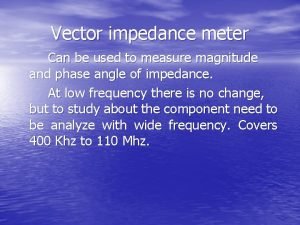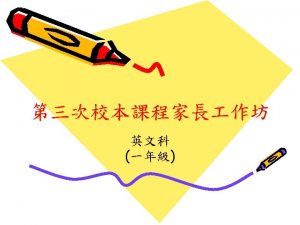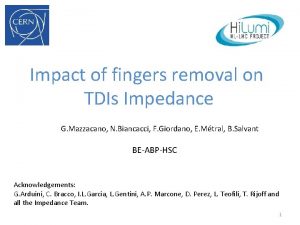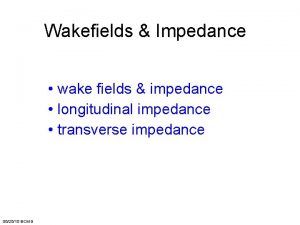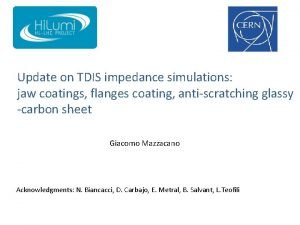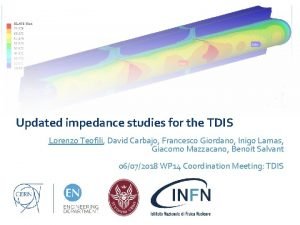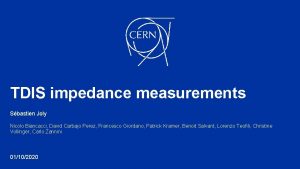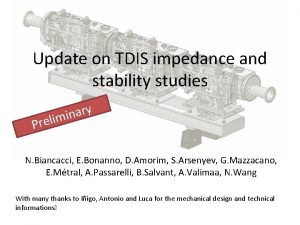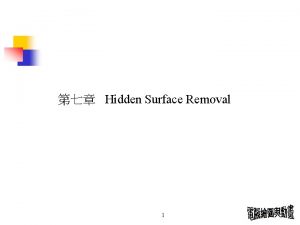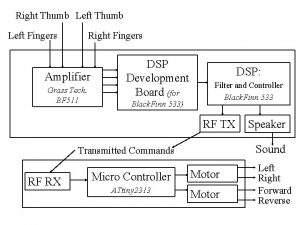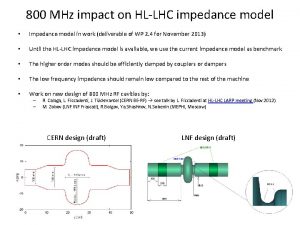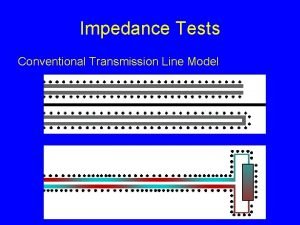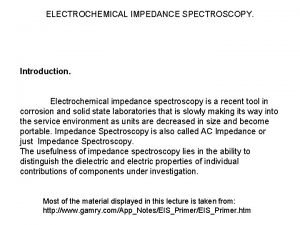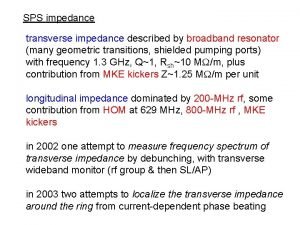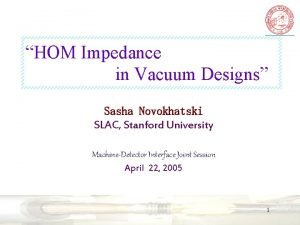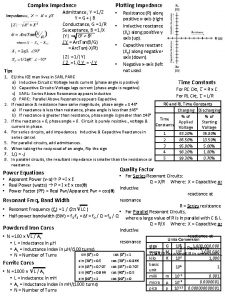Impact of fingers removal on TDIS impedance N
















- Slides: 16

Impact of fingers removal on TDIS impedance N. Biancacci, G. Mazzacano, E. Métral, B. Salvant WP 2 , 10 -08 -2017 Acknowledgements: G. Arduini, D. Carbajo Perez, L. Gentini, A. P. Marcone and all the colleagues who helped at the TDIS review.

Introduction The LHC TDI is one of the most important contributors to the LHC machine impedance at injection. Being 3. 8 mm close to the beam, may have critical impact if impedance is not minimized or non conformities are found (see HBn coating issues on TDI in 2015) A new TDI design has been proposed for HL-LHC, the TDIS, segmented in 3 tanks in order to: • Improve mechanical reliability. • Allow module exchangeability. At the TDIS review on 01/12/2016 an overview of the TDIS impact on impedance together with impedance reduction recommendations where given. “TDIS v 1. 0” for us Main recommendation concerning fingers were: 2

Introduction On 12/05/2017 a change of the main TDIS jaw dimension was communicated to the impedance team. The width of the absorbing jaws was shortened from 80 to 62 mm “TDIS v 2. 0” for us The change in jaw width is being addressed by the impedance team: model available since end of May. On 02/08/2017, Antonio made a request to study the possibility of removing the fingers between contiguous jaws (longitudinal fingers) In this presentation we summarize the impact on impedance and beam stability of removing the longitudinal fingers focusing on the HOMs that are introduced. We give only a rough estimate of the HOM impact (as was not foreseen for the simulations!) Due to the complexity of the device and the number of HOMs introduced a detailed analysis is needed for the TDIS updated model. 3

Connected jaws (1 jaw) Segmented jaws (3 jaws) • Removing the jaw connection introduces a large amount of HOMs! • A detailed quantification of the effect on heating and stability needs heavy amount of Eigenmode simulations. 4 • Rough estimates given in the following.

RF fingers in the TDIS design Lateral RF fingers Longitudinal RF fingers to be removed 5

Effect of longitudinal fingers on impedance TDIS v 1. 0 Longitudinal RF fingers • No visible HOMs in longitudinal impedance below 1. 2 GHz if granted continuity of image current flow with longitudinal RF fingers. 6

Effect of fingers removal on heating Cu jaws, 5 mm half gap TDIS v 1. 0 Model with Cu jaws • HOMs are introduced removing the longitudinal fingers and/or lateral ones. • Black curve shows impact with no longitudinal RF finger but with lateral RF fingers. • Heating from HOM evaluated with statistical approach (+/- 20 MHz uncertainty) • 300 W max power dissipated around 500 MHz (may change on the updated model of the TDIS and with Eigenmode analysis) • Summing all the HOMs is not a priori correct as we should check where the heat is deposited. 7

Effect of fingers removal on heating • Simulations being updated by G. Mazzacano on TDIS v 2. 0 • Strong fingers effect on longitudinal impedance confirmed. • Few 100 W at max per HOM around 800 MHz. • Dependence on gap not straightforward, need to check in detail. Model with graphite jaws Preliminary simulations from G. Mazzacano Many thanks for all this work 8

Effect of fingers removal on heating TDIS v 2. 0 • Simulations being updated by G. Mazzacano on TDIS v 2. 0 • Strong fingers effect on longitudinal impedance confirmed. • Few 100 W at max per HOM around 800 MHz. Model with graphite jaws • Dependence on gap not straightforward, need to check in detail. Preliminary simulations from G. Mazzacano 9

Effect of fingers removal on heating TDIS v 2. 0 • Simulations being updated by G. Mazzacano on TDIS v 2. 0 • Strong fingers effect on longitudinal impedance confirmed. • Few 100 W at max per HOM around 800 MHz. Model with graphite jaws • Dependence on gap not straightforward, need to check in detail. Preliminary simulations from G. Mazzacano 10

Comments on HOMs evaluation • The heating calculated so far might be underestimated as it is inferred with time domain Wakefield simulations. • If the longitudinal fingers are removed, we need to study in details the HOMs with Eigenmode simulations and check Q-factor and shunt impedance to refine the heating probability calculations. • The impact of filling pattern should be as well addressed (F. Giordano, B. Salvant) • Local power loss: HOMs can heat different locations. • What are the heat load tolerances on the TDIS components? • Can we foresee any vacuum issue? • Do we have someone to check it with thermo-mechanical simulations? Some expertise presented by L. Teofili on impedance meeting 14 -07 -2017. • Should we foresee an intermediate step between impedance calculations and design validation to account for local heat deposition effect studies? The impedance team can provide the power loss maps. • Transverse stability: Eigenmode simulations are as well needed to assess the impact on coupled bunch (mainly shunt impedance R of the modes) and single bunch (R/Q) from each HOM. 11

Timescale for impedance studies Finalization of the impedance and beam stability impact estimates on updated TDIS : Impedance calculations: broadband estimation, shunt impedance, Q factor HOM by HOM, especially without RF fingers in both longitudinal and transverse plane. ~20 days 1 -2 people Beam stability /heating calculations: DELPHI / filling pattern simulations at injection and flat top. ~10 days 2 people ~10 days 3 people from ABP + 1 helping from EN-STI ~2 days To be checked Prototype measurements: Long. /Transverse impedance wire measurements in circulating and injection positions at different gaps. . HOM characterization with probe/loop at different gaps. Broadband impedance with resonant wire method. Device exceptionally long: need to allocate enough time (see issue with TCSPM wire measurements) Additional measurements: If required: EM coupling on temperature probes 12

Conclusions and outlook • Impedance and instability studies on TDIS – Transition from TDIS v 1. 0 to TDIS v 2. 0 still under study. – Preliminary results confirm detrimental effect of removal of longitudinal RF fingers. – Order of few 100 W dissipated for strongest HOM. – Need to assess the impact also with thermo-mechanical simulations and on vacuum. – Need to do careful analysis HOM by HOM with Eigenmode Solver. – Impact on transverse stability being investigated. • Timescale requested: – – Impedance studies: 20 days – 2 people Instability studies: 10 days -2 people Prototype measurements: 10 days – 3 people from ABP + 1 from EN-STI Additional measurements: 2+ days depending on item and people availability. Key dates and milestones for design revisions and prototyping needed to plan well ahead all this work! 13

Thanks for your attention! 14

Backup 15

16
 Vector impedance meter block diagram
Vector impedance meter block diagram Where is intrapleural pressure
Where is intrapleural pressure Niccolo paganini fingers
Niccolo paganini fingers Forearm space of parona diagram
Forearm space of parona diagram Difficult airway algorithm
Difficult airway algorithm Best phone for fat fingers
Best phone for fat fingers Section 3 shaping evolutionary theory
Section 3 shaping evolutionary theory Hoot carl hiaasen summary
Hoot carl hiaasen summary Palmar pascial spaces
Palmar pascial spaces Radial pulse 3 fingers
Radial pulse 3 fingers A shedding of one or more nails either in whole or in part
A shedding of one or more nails either in whole or in part 5 fingers of evolution
5 fingers of evolution Fingers fing
Fingers fing 5 fingers of evolution
5 fingers of evolution Elbows off the table fingers off the food song
Elbows off the table fingers off the food song Victory waits on your fingers poster meaning
Victory waits on your fingers poster meaning Truman show fingers crossed meaning
Truman show fingers crossed meaning
